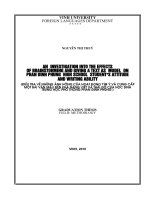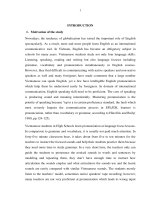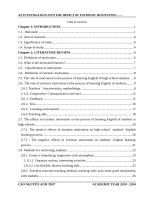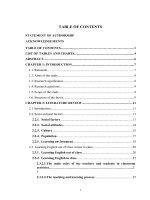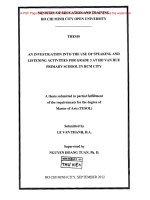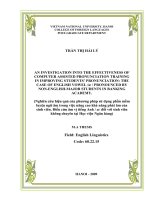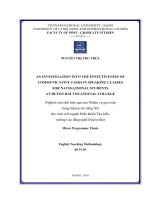An investigation into the use of translation method in vocabulary teaching and learning at Tran Nhan Tong High School, Hanoi = Nghiên cứu việc sử dụng phương ph
Bạn đang xem bản rút gọn của tài liệu. Xem và tải ngay bản đầy đủ của tài liệu tại đây (627.9 KB, 57 trang )
VIETNAM NATIONAL UNIVERSITY, HANOI
UNIVERSITY OF LANGUAGES AND INTERNATIONAL STUDIES
FACULTY OF POST-GRADUATE STUDIES
TRẦN THỊ VÂN
AN INVESTIGATION INTO THE USE OF TRANSLATION
METHOD IN VOCABULARY TEACHING AND LEARNING AT
TRAN NHAN TONG HIGH SCHOOL, HANOI
(Nghiên cứu việc sử dụng phương pháp dịch trong hoạt động dạy và
học từ vựng của giáo viên và học sinh trường THPT
Trần Nhân Tông, Hà Nội)
M.A Minor Programme Thesis
Field: English Language Teaching Methodology
Code: 60.14.10
HANOI, 2013
VIETNAM NATIONAL UNIVERSITY, HANOI
UNIVERSITY OF LANGUAGES AND INTERNATIONAL STUDIES
FACULTY OF POST-GRADUATE STUDIES
TRẦN THỊ VÂN
AN INVESTIGATION INTO THE USE OF TRANSLATION
METHOD IN VOCABULARY TEACHING AND LEARNING AT
TRAN NHAN TONG HIGH SCHOOL, HANOI
(Nghiên cứu việc sử dụng phương pháp dịch trong hoạt động dạy và
học từ vựng của giáo viên và học sinh trường THPT
Trần Nhân Tông, Hà Nội)
M.A Minor Programme Thesis
Field: English Language Teaching Methodology
Code: 60.14.10
Supervisor: Phạm Thị Thanh Thủy, M.A
HANOI, 2013
iv
LIST OF TABLES AND FIGURES
Table 1
Teachers‟ responses to the use of Vietnamese to explain new
words.
Table 2
Proportion of periods that teachers use translation exercises the
most.
Table 3
Aspects of vocabulary teachers pay the most attention to.
Table 4
Reasons for using translation exercises.
Table 5
Teachers‟ frequency of using Vietnamese to explain words‟
meaning
Table 6
Frequency of translating sentences which are not in context.
Figure 1
Percentage of teachers asking students to use bilingual
dictionary to look up new words.
Figure 2
Teachers‟ opinions about the effectiveness of Translation
exercises to vocabulary teaching.
Figure 3
Students‟ frequency of using bilingual dictionary to look up new
words.
Figure 4
Frequency of translation exercises given by teachers to students.
Figure 5
Students‟opinions about the effectiveness of translation
exercises.
Figure 6
Reasons for using translation exercises to learn new words.
v
TABLE OF CONTENTS
page
Declaration i
Acknowledgements ii
Abstract iii
List of charts and figures iv
Table of contents v
Part A: INTRODUCTION 1
1 Introduction 1
2 Aims of the study 2
3 Research questions 2
4 Scope of the study 2
5 Chapter summary 2
PART B: DEVELOPMENT
Chapter 1: Literature review 3
1.1 Vocabulary 3
1.1.1 Definitions of vocabulary 3
1.1.2 The roles of vocabulary in language teaching and learning 3
1.1.3 What should be taught in vocabulary 4
1.1.4 Explicit and incidental vocabulary learning 6
1.2 Translation Method
1.2.1. Translation Method in second language teaching 7
1.2.2. The influences of the first language on the second language 8
1.2.3. The use of translation to facilitate vocabulary teaching 11
1.2.4 Empirical studies of Translation Method in vocabulary teaching and 12
learning
1.3 Chapter summary 15
Chapter 2: Methodology 16
2.1 The design of the study 16
vi
2.2 Participants 16
2.3 The instruments 17
2.3.1 Survey questions 17
2.3.2 Class observation 18
2.3.3 Interviews 18
2.4 Data collection 19
2.5 Chapter summary 19
Chapter 3: Data analysis and discussion 20
3.1 Data analysis and discussions of survey questionnaires 20
3.2 Data analysis and discussion of interviews 30
3.3 Data analysis and discussion of class observation 34
3.4 Major findings 37
3.5 Pedagogical implications 39
3.6 Chapter summary 39
PART C: CONCLUSION 40
1. Conclusions 40
2. Limitations and suggestions for further study 41
REFERENCES 42
APPENDICES I
1
PART A: INTRODUCTION
This part consists of the introduction of the research, the aims that inspired the author
to do this study, the research questions, and the scope of the study.
1. Rationale and statement of the Study.
Learning vocabulary is an essential component in learning a second language.
Wilkins (1997:111) stated, “Without grammar very little can be conveyed, without
vocabulary nothing can be conveyed”. This statement shows us the importance of
vocabulary and how hard it is to be understood without vocabulary. It is a common
fact that when students cannot express any statements, they would look up the
dictionary to check new words.
A recent study by Ramachandran and Rahim (2004) investigated the effectiveness of
using the translation method in recalling the meaning and retention of the words with
elementary level ESL. Their results indicated that the translation method through
using the first language was more effective than the non-translation method in
enhancing ESL learners‟ vocabulary learning ability, and it could improve
elementary ESL learner‟s ability to recall the meaning of the word learnt. Auer Bach
(1993) claims that the use of the learner‟s L1 in the L2 classroom will have a positive
effect on learners‟ second language learning, especially in the area of vocabulary.
However, due to the continuously increasing demand for communication purposes,
nowadays many teachers feel interested in using Communicative Approach to teach
vocabulary, in which the implicit approach is used to teach students vocabulary by
emphasizing on guessing the meaning of the word by looking at the context where
the words are located or using visual aids to teach new words. Then the teachers
refuse to apply Translation Method, which mainly uses explicit instructions to
directly teach students vocabulary. Personally, the researcher is interested in the
findings of many researchers including Nation (2001) and Kroll and Curley (1988)
that new second language words are stored more effectively in the brain when they
are linked to their first language equivalents. So the author of this research make an
investigation into a concrete case (at Tran Nhan Tong High School) to find out the
2
answer for the question about the real situation of using Translation Method in
vocabulary teaching and learning at high school at the present.
2. Aims of the study
As it was stated before, there are a number of reasons for teachers to reject using
Translation Method in their teaching despite the fact that many researchers did
studies and found out that this method had positive effect on students‟ vocabulary
acquisition. Therefore, the author did this research to investigate the real situation of
applying Translation Method in vocabulary teaching and learning of teachers and
students at Tran Nhan Tong High School. The researcher would like to know whether
they are applying this Method to their teaching and learning or not, and if Translation
Method is still used, how the teachers and students think about its effectiveness
towards their vocabulary teaching and learning.
3. Research Questions
1 How is Translation Method applied in vocabulary teaching and learning at
Tran Nhan Tong High School?
1. How effective do teachers and students at Tran Nhan Tong High School find
the Translation Method to their vocabulary teaching and learning?
4 The scope of the study
In this study, the researcher would like to investigate the real situation of applying
Translation Method in vocabulary teaching and learning field, not second language
learning in general; therefore, the observation mainly happened in reading, language
focus and writing periods.
5 The summary
In this first part, the author introduced the thesis with the aims that inspired her to
conduct the study as well as the research questions. The author also presented the
scope of the study that the thesis‟s focus was the application of Translation Method
in vocabulary teaching and learning so she did not pay attention equally to all lessons
of the participants.
3
PART B: DEVELOPMENT
Part B consists of three chapters: literature review; methodology and data analysis
and discussions.
Chapter 1: Literature review
This chapter looks at the literature review of Translation Method and vocabulary
teaching. The summaries of previous researches on closely –related topics are also
included.
1.1 Vocabulary
1.1.1 Definitions of vocabulary
According to Penny Ur (1996:60), the vocabulary was roughly defined as “the words
we teach in the foreign language.” It was also accepted that “a new item of
vocabulary may be more than a single word: for example, post office and mother-in-
law, which are made up of two or three words but express a single idea”. Added to
that, Michael Lewis (1993:89) said that vocabulary “may be individual words or full
sentences - institutionalized utterances - that convey fixed social or pragmatic
meaning within a given community". According to Cambridge Advanced Learner's
Dictionary Third Edition (2008), vocabulary is defined as “all the words which exist
in a particular language or subject” (p.1624). This definition covers vocabulary‟s
meaning on the whole. However, it is not the knowledge of words and word
meanings, vocabulary is more complex than this definition suggests. The definition
does not totally show a deep understanding about vocabulary.
In conclusion, there are many different definitions about vocabulary, but the idea that
vocabulary is the total number of words existing in a language, including single
words as well as multi-word items of which meaning cannot be deduced from the
analysis of the component words but only understood in the sentences; or in contexts,
is more favorable.
1.1.2 The roles of vocabulary in language teaching and learning
4
It is widely accepted that vocabulary is the most important language element among
pronunciation, vocabulary and grammar. Wilkins (1972:111) emphasizes the special
role of vocabulary in teaching and learning a language. Shafaei and Nejati (2009)
also strongly supported this idea that “vocabulary is one of the most important
objectives in teaching of foreign languages” (p. 32).
Vocabulary is important in all four language skills. In terms of speaking, it is
impossible to communicate without vocabulary. In addition, sometimes, students
have difficulties in finding the proper words to express themselves. In terms of
listening, the vocabulary errors caused confusion of the texts and difficulty in
listening comprehension. Most importantly, vocabulary plays a role in reading. It is
indicated that the lack of vocabulary is the most significant obstacle for readers, which
prevents them from thoroughly comprehending the text. Therefore, vocabulary is a
language component that plays an important role in deciding a learner‟s language
proficiency. If a learner has a wide range of vocabulary, it is easy to understand
others; on the contrary, if his vocabulary is limited he will surely have difficulty in
communication.
1.1.3 What should be taught in vocabulary
Richards (1976) claims that knowing a lexical item includes knowledge of word
frequency, collocation, register, case relations, underlying forms, word association
and semantic structure. Nation and Newton (1997) look into the principled selection
of vocabulary through the following dimensions: frequency; range; the ability to
combine, define or replace other words; association; and availability. However, Penny
Ur‟(1996) states that when teaching a new English words, the teacher should provide
the learners with its pronunciation and spelling, word form, grammar, collocation,
aspects of meaning, word-formation.
Word form
Each English word has its spelling and pronunciation. Learners have to know all the
spelling, pronunciation and irregularities of the word they are learning.
Grammar
5
The grammar of a new word should also be taught to the learners. They need to know
the grammatical function, the unpredictable change of form in certain grammatical
contexts, the regularity and irregularity, the singular and plural forms of the new
word so that they can use it correctly. For example, teaching the verb “pay”, we
might give its irregularity in past form “paid”; when a noun such as “a foot” is
taught, it should be given its plural form as “feet”.
Collocation
Collocation is the way in which words are used together regularly in a specific
language. It refers to the restriction on how words can be used together in right
contexts. Thus, this is another piece of information about a new item, which may be
worth teaching. When introducing words like “to make” and “to do”, for example,
the teacher may note that both words mean, “to perform” but can be distinguished by
the words they collocate with. We often say, “to do the shopping” but never say, “to
make the shopping”.
Aspects of meaning
Aspect of meaning consists of denotation, connotation, appropriateness and meaning
relationship.
The denotation meaning refers to or point out things, concepts. This is often the sort
of definition given in dictionaries such as "cat" denotes a small animal with soft fur,
often kept as a pet or for catching mice.
Connotation of a word is less obvious component of its meaning. This is association,
or positive and negative feelings the word evokes which may not be indicated in a
dictionary definition. Connotation includes stylistic, affective, evaluation,
intensifying value, pragmatic communicative values, the word acquires by virtue of
where, when, how and by whom, for what purpose and in what context it is or it may
be used.
Appropriateness is more subtle aspect of meaning that indicates whether a particular
item is appropriate one to use in a certain context or not. Thus, it is useful for a
learner to know whether a certain word is very common, or relatively rare or taboo in
6
a polite conversation, or tends to be used in writing but not in speech, or is more
suitable for a formal than informal discourse or belongs to a certain dialect. For
example, the word “daddy” is widely understood to be “father”, but it is only used in
informal way to show the close relationship between children and father. This word
may never be used in formal document.
Word-formation
Word can change their shape and their grammatical value. Vocabulary items whether
one-word or multi-word can often be broken down into their components "bits".
Students need to know facts about word formation and how to use words to fit
different grammatical contexts.
In summary, three main components that students need to know when learning a
new word are the form, meaning and usage.
1.1.4 Explicit and incidental vocabulary learning
Explicit vocabulary learning focuses on teaching vocabulary directly to learners in
order to enhance the chance of new vocabulary acquisition. Even though that explicit
teaching strategy is time consuming, it is worth the time to teach second learners the
most frequent words in a language and technical vocabulary that learners will need in
order to succeed in their education field.
On the other hand, incidental vocabulary learning can occur when learners focused
on comprehending meaning rather than focusing on learning new vocabulary (Gass
and Selinker, 2001). Incidental learning can occur from reading or from having
conversations with others who speak the language. Words that not explicitly taught
can be learned incidentally from exposure. It is necessary to increase the amount of
exposure in order to enhance the incidental vocabulary learning because the lack of
exposure is one of the problems facing the incidental approach (Schmitt, 2000). A
learner can start learning vocabulary incidentally from conversation from the
beginning, but when it comes to reading, a certain amount of explicit instruction is
necessary.
7
Written language usually uses more low frequency vocabulary than spoken language;
thus, teaching these infrequent words explicitly for second language learners is
necessary especially for learners at elementary levels. Thus, explicit teaching is
necessary for low proficiency learners until they reach a vocabulary size threshold
that allows them to learn words incidentally from reading (Schmitt, 2000). Sokmen
(1997) states that “the pendulum has swung from direct teaching of vocabulary the
grammar translation method) to incidental (the communicative approach) and now,
(laudably, back to the middle: implicit and explicit learning” (as cited in Schmitt,
2000, p. 120). These studies suggest that both explicit and incidental learning are
necessary, and they should complement each other.
In conclusion, both incidental and explicit learning are necessary and they should be
used together to bring the highest effectiveness.
1.2 Translation Method in second vocabulary language teaching
1.2.1 Translation Method in language teaching
Grammar Translation Method was the predominant teaching methodology from the
beginning of the nineteenth century. It was developed based on a procedure for
teaching Latin and evolved out of the need to standardize foreign language teaching
for children (Howatt, 1984, as cited in Schmitt, 2000). Students were given extensive
grammatical explanation in their first language, lists of bilingual vocabulary, and
some practice exercises to translate from the first language into the second language
or vice versa. In this method, the content focused more on reading and writing skills.
Vocabulary was only used as a way of illustrating grammar rules (Zimmerman, 1997,
as cited in Schmitt, 2000). Students were expected to learn new vocabulary
themselves by using bilingual word lists; thus, the bilingual dictionaries became an
important reference tool. Steinberg and Sciarini (2006) stated that the Grammar-
Translation Method “has enjoyed and continues to enjoy acceptance in many
countries around the world,” especially in countries where language teachers are not
fluent and the classes are very large (p. 114).
8
Despite its advantages, there are many problems associated with the Grammar-
Translation Method. One of the main problems with Grammar- Translation Method
was that it focused on language analysis instead of language use. It also focused on
reading and writing skills which did not help to develop the ability to communicate
orally in the target language (Schmitt, 2000). Therefore, this method aims at
providing students with a detailed literary vocabulary which is learned through long
lists of translated items and a bilingual dictionary and practiced through sentence
translation with little opportunity to try out pronunciation (Rivers, 1981:28-30).
Murcia and Prator (1979:3) listed major characteristics of Translation Method:
Classes are taught in the mother tongue, with little active use of target
language.
Much vocabulary is taught in the form of lists of isolated words.
Long elaborate explanations of the intricacies of grammar are given.
Grammar provides the rules for putting the words together and instruction
often focuses on the form and inflections of words.
Reading of difficult classical texts is begun early.
Little attention is paid to the content of texts, which are treated as exercises in
grammatical analysis.
Often the only drills are exercises in translating disconnected sentences from
the target language into the mother tongue.
Little or no attention is given to pronunciation.
1.2.2 The influences of first language on the second language
Many researchers have found out that the learners‟ first language has great
influence on the learning and the use of second languages. Second language learners
use their L1 in learning the target language in many ways. Many Vietnamese students
have ever said “What is the Vietnamese word for… ”, if they do not get the answer,
9
immediately they will look up the bilingual dictionaries to find unknown vocabulary.
Even though when this does not happen, an immediate association with a mother –
tongue word is likely to be set as soon as possible. There are complaints about the
influence of the first language on second language vocabulary learning because it
takes time for students and teachers to think in the first language before they have the
right word in second language. However it even takes more time to explain a word
without translating because the teacher has to spend several minutes to find other
simple words or materials to make students understand. According to Schmitt
(Schmitt, 1997) many second language learners believe that translating helps them in
learning second language skills such as reading, writing, vocabulary…
Atkinson (1987) not only acknowledges the positive role of the mother tongue in the
classroom, but also identifies the following uses of it: eliciting language, checking
comprehension, giving instructions, enhancing co-operation among learners,
promoting discussions of classroom methodology, improving presentation and
reinforcement of language, checking for sense testing, and development of useful
learning strategies. The following are several reasons why the first languages should
be used as a tool in the language classroom:
It is more natural to use the first language with others who have the same first
language.
It is easier and more communicatively effective to use the first language.
Using the second language can be a source of embarrassment particularly for
shy learners and those who feel they are not very proficient in the second language.
The first language can help to move the task along by establishing a joint
understanding of the text and to manage the task.
The first language allows learners to focus attention on vocabulary and
grammatical items or providing information and explanation about grammatical rules
and conventions.
The first language may facilitate classroom activities, particularly for low
proficiency students and complex tasks.
10
The first language can provide a foundation for learners on which to build the
second language structures, especially during collective activities in the classroom,
and the first language provides a sense of security and validates the learners‟ live
experiences, allowing them to express themselves.
The first language can make learners feel more confident of using the second
language, especially when their level is low.
Using the first language to explain, teachers can save a lot of time.
On the contrary, using the first language causes some interference errors in
English because there is not always equivalence between the two languages. For
example, in Vietnamese, “nhà tôi” can have two equivalents in English depending on
the context: “ nhà tôi” can be “my house” or “my wife” or “ my husband”. Some
languages like Swedish and English share some characteristics which led learners to
think that a word or structure what works in Swedish will work in English. Sokmen
(1997) states that vocabulary teaching was based on a top – down, naturalistic, and
communicative approach which emphasized implicit and incidental learning of
vocabulary. Inferring from the context and guessing are considered to be implicit
teaching. The implicit approach is commonly used in foreign language teaching
classrooms. Teachers often encourage students to guess the meaning of the word by
looking at the context where the words are located. They rarely use the first language
in the classroom because they are concerned that students may just rely on their first
language. Using the first language may lead students to the conclusion that learning a
foreign language is just by translating it or foreign language is the first language in
another form.
In short, the first language may support learners to learn the second language, once
they understand their first language they can apply it into their second language
learning. Sometimes it may not help, and it even causes difficulties for learners
because of the two language differences.
11
1.2.3 The Use of Translation to facilitate vocabulary teaching
As it was discussed in the previous section, learners‟ first language has a great impact
in the learning of the second language. Thus, we come to the question: should
translation be used in teaching and testing second language vocabulary? There may
be a belief that first language translation should not be used in the teaching of
vocabulary. However, translation is one of number of ways of conveying meaning
and it is not better or worse than other ways, such as the use of pictures, real objects,
definitions, the second language synonyms and so on. Actually, the use of learners‟
first language to test or convey vocabulary is quite sufficient (Nation, 2001).
One of the greatest advantages of using learners‟ first language in vocabulary
teaching is that it provides an easier way to explain the meaning of second language
vocabulary. The use of the learners‟ first language meaning is like using a simple
synonym, while a second language definition usually involves a definition that
includes a relative clause or reduced relative clause, and reading such sentences
require greater grammatical skills.
The use of first language translation provides a useful mean of testing vocabulary,
both receptively and productively, and in recall and recognition of meaning. The
difficulties that caused by no exact corresponding between meanings in both
languages are less than the difficulties that caused by the lack of connection between
the second language definitions and the meaning they are trying to convey. As a
result, using learners‟ first language translation to establish the initial form - meaning
of the new second language words‟ form with the corresponding the first language
words which already exist in the memory is very useful (Barcroft, 2002). Moreover,
new second language words are stored more effectively in the brain when they are
linked to their first language equivalents (Kroll and Curely, 1988 , as cited in
Barcroft, 2002). Thus, using first language translation is a good method to teach
second language words as any other methods.
12
1.2.4 Empirical studies of Translation Method in vocabulary teaching and learning
There are numbers of researches on the effectiveness of Translation Method in
second language teaching in general, and in vocabulary teaching and learning in
particular. Haijti (1989) examined conditions in which oral translation was used as an
exercise to build vocabulary knowledge. He stated that this activity led to effective
results. According to Shamash (1990) the learners started by writing about their lives
in their first language or a mixture of their first language and English. Then they
translated the text into English with the help of bilingual tutors or learners. By this
way, learners overcome the problems of vocabulary and language confidence. The
use of native language may attract those students who are at low level of English.
Such findings are in accordance with current theories of second language acquisition.
All of them emphasize that the use of the first language reduces anxiety and
consequently makes effective environment appropriate for learning. In another study
Knight (1994) investigated the effects of using dictionary on the retention of
unknown words during a reading activity. In this experiment students who used
computerized dictionary demonstrated more vocabulary knowledge than those
without access to a dictionary. Saggara and Alba (2006) also conducted a research to
investigate effectiveness of translation with elementary students and came to a
conclusion that using key word method and direct first language translation of the
second language words would lead to better second language vocabulary learning at
the early stages of acquisition. Majid and Hayati (2009) conducted a research to
make comparison between task – based instruction and translation method in the
effectiveness of learning vocabulary and found out that higher range of vocabulary
had been learnt in the translation group. Learning happened in the task group but not
as much as in the translation one. Doing translation the learners had time to focus on
every single word. Added to that, when looking up words in bilingual dictionaries,
learners paid attention to the meaning and the form of the words then considered
semantic relation of each word with its surrounding words. According to Ellis and
Beaton (1993, p.604) knowing a lexical item involves knowing various components
13
such as its spelling, phonological representation, word class, syntactic features and
delivered meaning. Current trends in language education mostly consider no role of
the mother tongue in language learning but many researches including study of Majid
suggest that translation method is effective in improving learners‟ ability to recall
meanings of words which are unknown to them. Pal Heltai (1988) did a research on
conditions in which oral translation can be an exercise to build vocabulary and he
came to a conclusion that translation is best used as a supplementary exercise to
practice and build vocabulary at advanced level under some conditions. In countries
where English is a foreign language, opportunities for naturalistic acquisition are
few, students have less chances to practice real English, therefore some activities like
translation can be beneficial for learners to reach motivation to learn new words. He
also stated that translation might, indirectly, through contributing to the learning of
vocabulary; help improve learners‟ communicative fluency. Another study is by
Ramachandran and Abdul Rahim (2004) to investigate the effectiveness of the
translation method in teaching vocabulary to elementary level English as second
language (ESL) learners. The authors sought answers to the following questions: Do
Malaysian elementary level ESL learners who learn words through translation
method recall the meaning of the words learnt more effectively and is the translation
method effective for lasting word meaning recall? The participants who participated
in this study consisted of 60 ESL learners from a secondary school in Penang,
Malaysia. Subjects who participated in this study were chosen because they met the
requirements of the study, which includes similar first language (Malay) and
elementary level ESL learners. The subjects were divided into two different groups.
One group was assigned as the control group and the other as the experimental group.
The experimental group received the translation method as the treatment; and the
control group received the non-translation method as the treatment. Three
instruments were used in the study: testing instruments, reading materials, and
teaching instruments. In order to choose the study‟s materials, the authors conducted
a preliminary test to select 20 unknown lexical items from 60 lexical items which
14
was taken from the „Word List for the English Language Program for the Secondary
Schools‟. The 45 preliminary tests was a multiple choice question format. In the test,
each of the 60 lexical items was supplied with four options which were the possible
definitions for a given lexical item. From the set of the 60 multiple choice questions,
20 lexical items which had the highest percentage of inaccurate response were chosen
to be used in the main study. In the treatment sessions, the experimental group was
taught the lexical items using the translation method, while the control group was
taught using a non-translation method. Each of the treatment sessions for the
experimental and the control group lasted for 70 minutes, once a week for four
weeks. English and Malay were used to teach the experimental group, and only
English was used to teach the control group. For the experimental group, the meaning
of the new lexical item was given in English and Malay and in English only for the
control group. After teaching the new lexical items, reading materials were given to
the subjects. The reading materials for the experimental group were simplified and
the occurrence of the lexical items in context was emphasized. However, the reading
materials for the control group were not simplified. At the end of each treatment
session, the participants were given an immediate test in which they had to provide
meanings for the lexical items learnt in the class. Subjects in both groups were
allowed to give their answer either in English or Malay. One month later, the subjects
were given a delayed post-test. In the delayed post-test, all the 20 lexical items were
tested using the same format that was used in the immediate test.
The authors analyzed the data using the Statistical Package for the Social Science
(SPSS). Recall the meaning of the lexical items was measured in terms of percentage
and mean of correct answers. The results revealed that the subjects in the
experimental group outperformed in both the immediate recall test and the delayed
post-test of the meaning of lexical items. The results of the study show two
characteristics of the translation method that may have contributed to the
outperformance in word meaning recall by the 46 participants receiving it. First,
given that participants‟ second language lexical knowledge is limited, instruction in
15
their first language may have made their learning of second language lexical items
more effective. Second, the subjects found learning the new lexical items using their
first language less tedious than trying to understand different explanations in English.
The findings of the study show that elementary level ESL learners recall the meaning
of the words learnt effectively by using the translation method. The study also reveals
that the effects of the translation method is more lasting for word meaning than recall
among elementary level ESL learners. At the end, translation method seems to have
positive impact on ESL elementary learners‟ recall and retention of meaning of
vocabulary learning.
1.3 Chapter summary.
The current chapter summarizes the previous studies on Translation Method
towards second language learning and vocabulary teaching and learning in particular.
It also covers the influence of the first language to the second language acquisition.
There are different, controversial ideas on that, however; many researchers found out
that the first using translation method and the first language bring benefits to
students, especially to lower level ones. The term “word” and all issues surrounding
such as what should be taught in vocabulary, the role of vocabulary in a language,
incidental and explicit vocabulary teaching are all included.
16
Chapter 2: Methodology
This chapter consists of the design of the study; the participants; the three
instruments, namely questionnaires, interviews; observation and finally the data
collection.
2.1 The design of the study
The author chose survey research to do this study because of many reasons. First of
all, the author could gather a great number of opinions from participants. As the aim
of this study was to investigate the application of Translation Method in a high
school, the researcher needed a big number of participants to get the most reliable
result. The author could save a lot of time by getting the answers from delivering
questionnaires in class and then interviewing some participants in person. It took the
author one month from November to December to collect the data. The research
adopted a mixed methodology – both qualitative and quantitative approaches in data
collection and data analysis.
The study consisted of 5 chapters which covered the introduction of the research, the
literature review, the methodology, the data analysis and discussion and the
conclusion chapter.
There are three instruments which were used in this study, namely questionnaire,
interview and observation. Therefore the author could have very reliable findings at
the end. The questionnaires were delivered to all participants with both close
questions and open questions so that they can specify their opinions. The researcher
did the observation on her own with the checklist at class. The interviews consisted
of semi structured interviews and free interviews. The researcher interviewed two
teachers and five students.
2.2 Participants
The research participants were all from Tran Nhan Tong High School which is a
good high school in the center of Hanoi. About 200 male and female students and 6
female teachers of Tran Nhan Tong High School participated in the research. There
were two types of classes that the author took students from: 3 gifted English classes
17
at grade 10
th
, 11
th
, 12
th
where students were considered quite good at English and
other classes with students at elementary level. Three gifted classes were the best
English classes in the school. Three other classes were randomly selected under one
condition that these 6 classes have different English teachers. The students from
gifted class had 4 periods of English meanwhile students from other classes had 3
periods per week. The textbooks being used were the official English textbooks for
10
th
, 11
th
, 12
th
grade.
In terms of 6 volunteer teachers participating in the study, three of them were quite
young with no more than 5 year teaching experience; two of them had less than 10
year experience. There was only 1 teacher who had been teaching for 14 years in this
school. They were English teachers of those 6 classes I chose. They were helpful to
assist the author to deliver students the questionnaire and get their answers
2.3 The instruments
2.3.1 Survey questionnaires
There are 8 different questions in each questionnaire that the author delivered to six
teachers and about 200 students in their break time. The questionnaire for students
was in Vietnamese so they could clearly understand each question and respond to
them without any language barrier. All the questions designed were to seek answers
for 2 big research questions:
There are two research questions:
1. How is Translation Method applied in vocabulary teaching and learning at
Tran Nhan Tong High School?
2. How effective do teachers and students at Tran Nhan Tong High School find
the Translation Method to their vocabulary teaching and learning?
7 questions are closed questions, and the participants responded by circling their
choices. So they could save much time. Some of the questions sought answers for
frequency of actions which were typical characteristics of Translation Method such
as using Vietnamese to explain the meaning and usage of the new words or using
18
translation exercises to help students drill new words or using dictionary to look up
new words, etc. Other questions looked for participants‟ opinions about the
effectiveness of Translation exercises to their new vocabulary learning and teaching
and the reasons for their choices. The researcher also spent 2 first questions to
investigate the personal information of students and teachers such as their language
proficiency, their teaching experience….so that the author could see differences in
their viewpoints about the use of Translation Method if they had any.
The last question was an open ended question which allowed participants to specify
their ideas about the effectiveness of using Translation Method. This question was
also the key question that may facilitate the researcher to directly interview some
teachers and students for more ideas. (See appendix 1,2).
2.3.2 Class observation
Besides using questionnaires and interviews to get deeper ideas from teachers and
students the researcher came to some classes and observed by herself. The author
always asked the teachers in advanced then attended the classes randomly, so the
lessons could go on as planned. The author used an observation checklist with typical
characteristics of Translation Method such as using Vietnamese to explain the
meaning and the usage of the new words; asking students to use bilingual dictionary
and giving translation tasks. (See appendix 5).Besides the checklists, she did not
forget to take note other things which happened in class. The researcher believed that
these notes could lead her to other issues. The author observed the classes in all
listening, speaking, reading, writing and language focus lessons. However, as it was
stated in the scope of the study, she put more time to reading; writing and language
focus rather than listening and speaking lessons.
2.3.3 Interviews
The author interviewed 2 teachers and 5 students about the issues relating to
Translation Method. The interviews were conducted after the author collected the
answers for the research questionnaires. The author interviewed each participant for
about 2 minutes in the break time. There were 2 questions in each interview. (See
19
appendix 3,4). For students, the author focused on asking for the effectiveness of
Translation Method to their vocabulary learning; their thinking about using
Vietnamese and using bilingual dictionary to learn new words. The first question for
the teachers is similar to the first question of students: about the effectiveness of
Translation Method. The second sought answers for difficulties that teachers have to
deal with when applying Translation Method to teach vocabulary. Both teachers and
students‟ interviews were conducted in Vietnamese so that they can express
themselves more comfortably. The aims of the interviews were to generate in depth
information from teachers and students‟ ideas about the use of Translation Method
and its effectiveness in vocabulary teaching and learning.
2.4 Data collection
With permission from teachers, the author delivered questionnaires to them and their
students at the last 15 minutes of their periods. While respondents answered the
questions, she was there to clarify any questions that they did not understand clearly.
There were 6 teacher questionnaires and 200 student questionnaires that the
researcher delivered and collected after they finished. Then the author analyzed
questionnaires, conducted interviews with 2 teachers and 5 students to get deeper
information. The author used checklists and written notes when observing 8 classes,
in detail: 2 periods of reading, writing, language focus and 1 period of speaking and
listening.
2.5 Chapter summary.
This chapter includes the design, description of participants, research instruments and
the data collection of the study. This study was a survey research which used the
mixture of methodology: qualitative and quantitative approaches. 200 students and 6
teachers of Tran Nhan Tong high school were the participants. They not only
answered the questionnaires but were interviewed to express their ideas about the use
of Translation Method in vocabulary teaching and learning. The author also observed
their classes with checklist and written notes to get more reliable data for the study.
20
Chapter 3: Data analysis and discussions.
This chapter looks at the data analysis, the discussion and the major findings of the
study.
3.1 Data analysis and discussion of survey questionnaires
Analysis of teacher questionnaires’ results:
As it was stated before, the two first questions were used to ask for teachers‟
background information. Only 1 out of 6 teachers had more than 10 years teaching in
this school, the rest of them are quite young with from 3 to less than 10 year
experience.
Question 3: How often do you use Vietnamese to explain the meaning of the new
words?
Frequency
Number of teacher
Percentage
Always
0
0%
Often
5
83%
Sometimes
1
17%
Seldom
0
0%
Never
0
0%
Table 1: Teachers’ responses to the use of Vietnamese to explain new words.
This table indicates that 5 out of 6 teachers often use Vietnamese to explain the
meaning of new words. The number 83% is much greater than that of teachers who
sometimes or seldom or never use Vietnamese for new word explanation. There is
not a teacher who always uses Vietnamese to explain new words‟ meaning; it means
that they sometimes apply other techniques to help students understand the meaning
besides using Vietnamese. However the number of teachers who often uses
Vietnamese in these cases still outnumbers. According to the table, 100% of the
teachers refuse the choices “seldom” and “never”. Therefore, it can be concluded that
